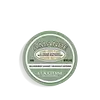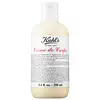What's inside
What's inside
 Key Ingredients
Key Ingredients

 Benefits
Benefits

 Concerns
Concerns

 Ingredients Side-by-side
Ingredients Side-by-side

Water
Skin ConditioningCaprylic/Capric Triglyceride
MaskingGlycerin
HumectantHelianthus Annuus Seed Oil
EmollientCetearyl Alcohol
EmollientOlus Oil
EmollientPrunus Amygdalus Dulcis Oil
Skin ConditioningButyrospermum Parkii Butter
Skin ConditioningC10-18 Triglycerides
EmollientCetyl Palmitate
EmollientHydrogenated Vegetable Oil
EmollientCetearyl Glucoside
EmulsifyingCarbomer
Emulsion StabilisingCaprylyl Glycol
EmollientSodium Stearoyl Glutamate
CleansingEthylhexylglycerin
Skin ConditioningSodium Gluconate
Skin ConditioningXanthan Gum
EmulsifyingTocopherol
AntioxidantSodium Hydroxide
BufferingParfum
MaskingLimonene
PerfumingLinalool
PerfumingCoumarin
PerfumingCI 77492
Cosmetic ColorantWater, Caprylic/Capric Triglyceride, Glycerin, Helianthus Annuus Seed Oil, Cetearyl Alcohol, Olus Oil, Prunus Amygdalus Dulcis Oil, Butyrospermum Parkii Butter, C10-18 Triglycerides, Cetyl Palmitate, Hydrogenated Vegetable Oil, Cetearyl Glucoside, Carbomer, Caprylyl Glycol, Sodium Stearoyl Glutamate, Ethylhexylglycerin, Sodium Gluconate, Xanthan Gum, Tocopherol, Sodium Hydroxide, Parfum, Limonene, Linalool, Coumarin, CI 77492
Water
Skin ConditioningHydrogenated Polyisobutene
EmollientGlycerin
HumectantCoco-Caprylate/Caprate
EmollientPropylene Glycol
HumectantPEG-100 Stearate
Glyceryl Stearate
EmollientSqualane
EmollientStearyl Alcohol
EmollientHelianthus Annuus Seed Oil
EmollientButyrospermum Parkii Butter
Skin ConditioningMyristyl Alcohol
EmollientPPG-5 Pentaerythrityl Ether
EmollientPEG-5 Pentaerythrityl Ether
EmollientOlea Europaea Fruit Oil
MaskingSesamum Indicum Seed Oil
EmollientDimethicone
EmollientPhenoxyethanol
PreservativeIsopropyl Palmitate
EmollientCitric Acid
BufferingCera Microcristallina
Emulsion StabilisingPentaerythrityl Tetra-Di-T-Butyl Hydroxyhydrocinnamate
AntioxidantChlorphenesin
AntimicrobialPotassium Sorbate
PreservativeGlycine Soja Sterols
EmollientArgilla
AbrasiveXanthan Gum
EmulsifyingSodium PCA
HumectantAllantoin
Skin ConditioningPrunus Amygdalus Dulcis Oil
Skin ConditioningPrunus Armeniaca Kernel Oil
MaskingTheobroma Cacao Seed Butter
EmollientPersea Gratissima Oil
Skin ConditioningTocopherol
AntioxidantGlycine Soja Oil
EmollientLecithin
EmollientAloe Barbadensis Leaf Juice Powder
Skin ConditioningCI 40800
Cosmetic ColorantWater, Hydrogenated Polyisobutene, Glycerin, Coco-Caprylate/Caprate, Propylene Glycol, PEG-100 Stearate, Glyceryl Stearate, Squalane, Stearyl Alcohol, Helianthus Annuus Seed Oil, Butyrospermum Parkii Butter, Myristyl Alcohol, PPG-5 Pentaerythrityl Ether, PEG-5 Pentaerythrityl Ether, Olea Europaea Fruit Oil, Sesamum Indicum Seed Oil, Dimethicone, Phenoxyethanol, Isopropyl Palmitate, Citric Acid, Cera Microcristallina, Pentaerythrityl Tetra-Di-T-Butyl Hydroxyhydrocinnamate, Chlorphenesin, Potassium Sorbate, Glycine Soja Sterols, Argilla, Xanthan Gum, Sodium PCA, Allantoin, Prunus Amygdalus Dulcis Oil, Prunus Armeniaca Kernel Oil, Theobroma Cacao Seed Butter, Persea Gratissima Oil, Tocopherol, Glycine Soja Oil, Lecithin, Aloe Barbadensis Leaf Juice Powder, CI 40800
 Reviews
Reviews

Ingredients Explained
These ingredients are found in both products.
Ingredients higher up in an ingredient list are typically present in a larger amount.
This ingredient is also known as shea butter. It is an effective skin hydrator and emollient.
Emollients help soothe and soften your skin. It does this by creating a protective film on your skin. This barrier helps trap moisture and keeps your skin hydrated. Emollients may be effective at treating dry or itchy skin.
Shea butter is rich in antioxidants. Antioxidants help fight free-radicals, or molecules that may harm the body. It is also full of fatty acids including stearic acid and linoleic acid. These acids help replenish the skin and keep skin moisturized.
While Shea Butter has an SPF rating of about 3-4, it is not a sunscreen replacement.
Shea butter may not be fungal acne safe. We recommend speaking with a professional if you have any concerns.
Learn more about Butyrospermum Parkii ButterGlycerin is already naturally found in your skin. It helps moisturize and protect your skin.
A study from 2016 found glycerin to be more effective as a humectant than AHAs and hyaluronic acid.
As a humectant, it helps the skin stay hydrated by pulling moisture to your skin. The low molecular weight of glycerin allows it to pull moisture into the deeper layers of your skin.
Hydrated skin improves your skin barrier; Your skin barrier helps protect against irritants and bacteria.
Glycerin has also been found to have antimicrobial and antiviral properties. Due to these properties, glycerin is often used in wound and burn treatments.
In cosmetics, glycerin is usually derived from plants such as soybean or palm. However, it can also be sourced from animals, such as tallow or animal fat.
This ingredient is organic, colorless, odorless, and non-toxic.
Glycerin is the name for this ingredient in American English. British English uses Glycerol/Glycerine.
Learn more about GlycerinHelianthus Annuus Seed Oil is the oil derived from the seeds of a Sunflower. Sunflower seed oil is non-fragrant. It is an emollient, meaning it helps to soften the skin.
Sunflower seed oil contains many fatty acids. The fatty acids found in sunflower seeds include (from highest amount to least): linoleic acid, myristic acid, palmitic acid, stearic acid, arachidic acid, oleic acid, and linolenic acid.
These fatty acids help the skin create ceramides. Ceramides play a role in repairing the skin barrier.
Helianthus Annuus Seed Oil helps moisturize the skin. This in turn helps the skin look more rejuvenated and smoother.
Sunflowers are rich in vitamin E.
Historians believe Indigenous cultures of North America domesticated sunflowers before corn. Thus they relied on sunflower oil for a variety of uses. One such use is moisturizing skin and hair.
Sunflower seed oil may not be fungal acne safe. We recommend speaking with a professional if you have any concerns.
Learn more about Helianthus Annuus Seed OilPrunus Amygdalus Dulcis Oil comes from the sweet almond, a tree native to Iran. This oil has no fragrance and is non-volatile.
Almonds contain healthy fats, vitamins, and minerals. It is a rich source of Vitamin E, a great antioxidant and skin conditioning ingredient. Sweet almond oil contains fatty acids such as linolenic acid and triglycerides.
The content of sweet almond oil makes it a great emollient; it can help soften and hydrate your skin. Emollients create a barrier over your skin to trap moisture in. Sweet almond oil has antioxidant properties.
Those with an almond allergy should be careful of this ingredient and speak with a professional about using it in your skincare.
This ingredient may not be fungal-acne safe.
Learn more about Prunus Amygdalus Dulcis OilTocopherol (also known as Vitamin E) is a common antioxidant used to help protect the skin from free-radicals and strengthen the skin barrier. It's also fat soluble - this means our skin is great at absorbing it.
Vitamin E also helps keep your natural skin lipids healthy. Your lipid skin barrier naturally consists of lipids, ceramides, and fatty acids. Vitamin E offers extra protection for your skin’s lipid barrier, keeping your skin healthy and nourished.
Another benefit is a bit of UV protection. Vitamin E helps reduce the damage caused by UVB rays. (It should not replace your sunscreen). Combining it with Vitamin C can decrease sunburned cells and hyperpigmentation after UV exposure.
You might have noticed Vitamin E + C often paired together. This is because it is great at stabilizing Vitamin C. Using the two together helps increase the effectiveness of both ingredients.
There are often claims that Vitamin E can reduce/prevent scarring, but these claims haven't been confirmed by scientific research.
Learn more about TocopherolWater. It's the most common cosmetic ingredient of all. You'll usually see it at the top of ingredient lists, meaning that it makes up the largest part of the product.
So why is it so popular? Water most often acts as a solvent - this means that it helps dissolve other ingredients into the formulation.
You'll also recognize water as that liquid we all need to stay alive. If you see this, drink a glass of water. Stay hydrated!
Learn more about WaterXanthan gum is used as a stabilizer and thickener within cosmetic products. It helps give products a sticky, thick feeling - preventing them from being too runny.
On the technical side of things, xanthan gum is a polysaccharide - a combination consisting of multiple sugar molecules bonded together.
Xanthan gum is a pretty common and great ingredient. It is a natural, non-toxic, non-irritating ingredient that is also commonly used in food products.
Learn more about Xanthan Gum